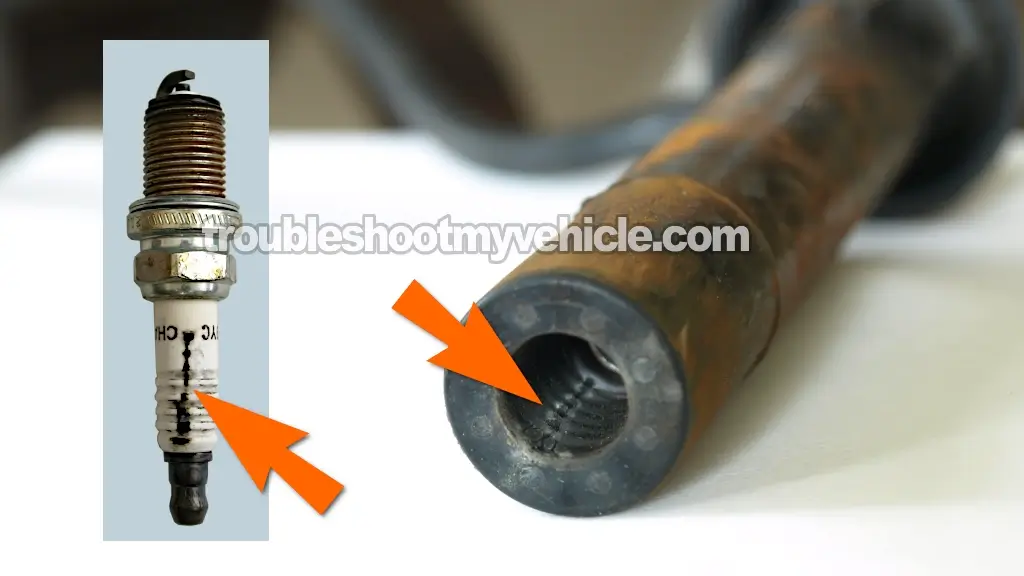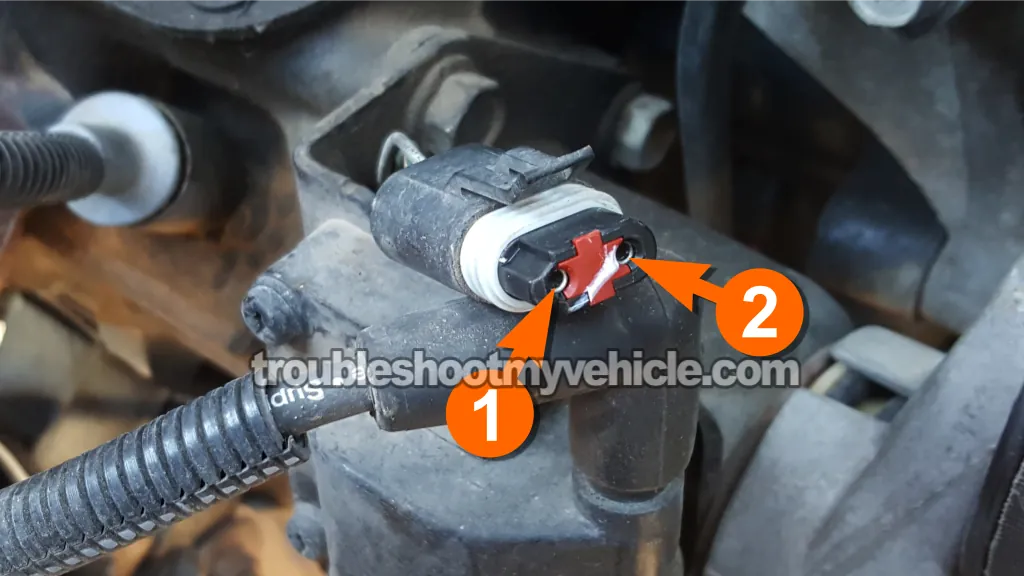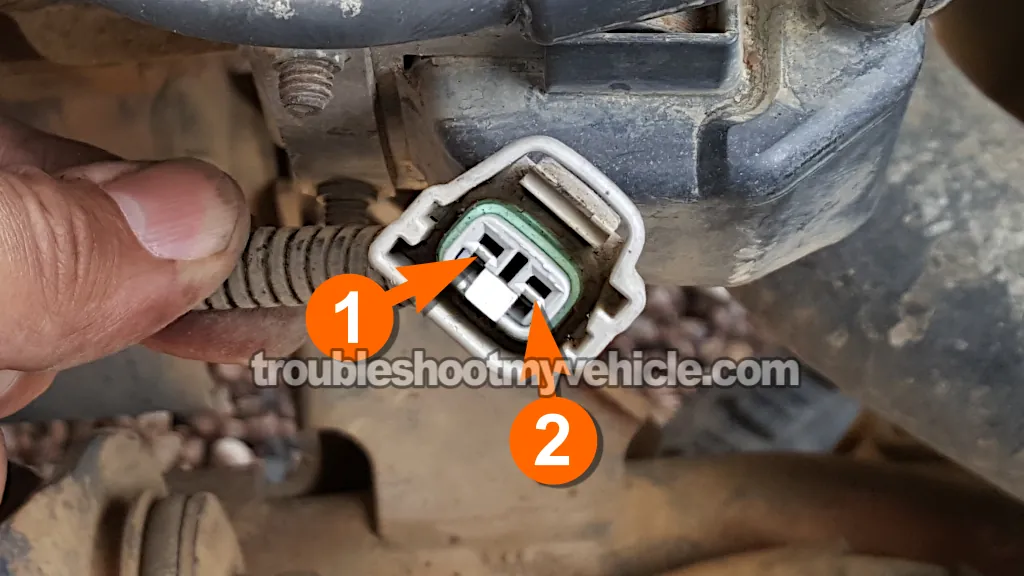TEST 6: Testing The Ignition Coil's Activation Signal
Up to this point, our ignition coil diagnostic tests have confirmed:
- TEST 1: All six spark plugs aren't sparking.
- TEST 3: The ignition coil's high-tension wire isn't sparking either.
- TEST 4: No spark coming straight from the ignition coil's tower.
- TEST 5: The ignition coil is getting powered up with 10 to 12 Volts.
Now for the final step in this guide: we're gonna check if the ignition coil is receiving its activation signal from the fuel injection computer (PCM).
This signal comes through the wire connected to terminal number 2 on the ignition coil's connector —see the photo above.
The wire that connects to this terminal will either be a grey (GRY) wire or black with grey stripe (BLK/GRY) wire, depending on your pickup's specific model year.
To check for this signal while cranking the engine, you'll use a simple 12-volt automotive test light.
If you don't have one, this is the one I use and recommend: Lisle 28400 Heavy Duty 12 Volt Test Light (at: amazon.com).
Let's jump into the test:
- 1
Connect the alligator clip on your 12V test light to the battery's positive (+) terminal.
- 2
Unplug the ignition coil from its 2-wire connector.
- 3
Use the metal probe on the test light to gently touch terminal 2.
Make sure you're probing the terminal actually connects to the GRY or BLK/GRY wire.
NOTE: Be careful not to jam the probe in —you could damage the terminal inside the connector. - 4
Have your helper crank the engine while you hold the probe steady on the terminal.
- 5
Watch for the test light to blink ON and OFF as the engine turns over.
NOTE: Don't worry about what the light does before or after cranking —only focus on what it does while the engine's cranking.
Here's how to read your results:
CASE 1: The test light blinked ON and OFF. That's the result you're looking for.
If you've confirmed all of this:
- No spark at any spark plug wire (TEST 1).
- No spark from the ignition coil's high-tension wire (TEST 3).
- No spark directly from the ignition coil tower (TEST 4).
- The ignition coil is getting 10–12 Volts (TEST 5).
- The ignition coil is receiving an activation signal (this test).
Then it's crystal clear —the ignition coil has failed. It's getting power and a signal, but not doing its job. Time to replace it.
Installing a new ignition coil should get your V6 Dodge Ram up and running again.
CASE 2: The test light didn't blink. That means the ignition coil isn't getting the activation signal —and without that signal, there won't be any spark.
Double-check your connections and rerun the test. If the light still won't blink, chances are high the issue is either the camshaft position (CMP) sensor —also known as the distributor pickup coil— or the crankshaft position (CKP) sensor.
Here's a step-by-step tutorial to help you test the CMP sensor:
- How To Test The Camshaft Position Sensor (1992-1995 3.9L V6 Dodge Ram Pickup).
- How To Test The Camshaft Position Sensor (1996-1997 3.9L V6 Dodge Ram Pickup).
- How To Test The Camshaft Position Sensor (1998-2001 3.9L V6 Dodge Ram Pickup).
CKP sensor tests:
- How To Test The Crankshaft Position Sensor (1992-1997 3.9L V6 Dodge Ram Pickup).
- How To Test The Crankshaft Position Sensor (1998-2001 3.9L V6 Dodge Ram Pickup).
Other Causes Of A Misfire

A misfire —or rough idle— can be caused by quite a few things. So if you ran through all the test in this tutorial and everything checked out, here are a few other things worth checking:
- Spark plug wires: Take a close look at each high tension wire.
- Make sure none of them are missing the little metal terminal inside the boot —that's the part that actually clips onto the spark plug. You'd be surprised how often someone yanks a wire off, leaves the terminal stuck on the plug, and hopes nobody notices (yep, really happens).
- Look for burn marks where a wire might've come into contact with the exhaust manifold. If the insulation's melted, the spark will arch to the engine right there instead of reaching the plug —and that'll cause a misfire.
- Spark plugs: Inspect the plugs themselves.
- Check for any cracks or chips in the porcelain insulator. That can happen if a plug was dropped during a tune-up and went unnoticed.
- If you've pressure washed the engine recently, that could be the issue too —water and EFI systems don't play nice together.
- Carbon tracking: Look for signs of carbon tracks on the plugs.
- These show up as thin, black lines along the porcelain or inside the spark plug boot. They can short the spark and trigger a misfire. The image above shows you exactly what to look for.
- This case study may be of help: Carbon Tracks Are A Common Cause Of Ignition Misfires (at: easyautodiagnostics.com).
- Engine compression: Low compression caused by worn piston rings or valves can also lead to misfires.
- Compression testing is one of the most skipped steps in misfire diagnosis —but it's a big one.
- Here's a full walkthrough on how to check compression: How To Test The Engine Compression (1989–2001 3.9L V6 Dodge Ram Pickup).
These real-world case studies (where I walk through how I tracked down and fixed misfire problems) might help too:
- Diagnosing A Toyota Corolla Misfire Case Study.
- Troubleshooting A Hard To Diagnose Misfire Case Study (GM 3.1L, 3.4L).
- Carbon Tracks Are A Common Cause Of Ignition Misfires (at: easyautodiagnostics.com).
Where To Buy The Ignition Coil And Save
The ignition coil for the 1992-2001 3.9L V6 Dodge Ram pickup is not an expensive part. The following links will help you to comparison shop and hopefully save you a few bucks on its purchase:
Disclosure: As an Amazon Associate, I earn from qualifying purchases. If my tutorials help you, using these links is an easy way to support the site at no extra cost to you. Thank you!
NOTE: The ignition coil fits the following vehicles: 1989 and 1991 3.9L V6 Dodge Ram pickup.
Where To Buy The Distributor Cap, Distributor Rotor, Spark Plug Wires And Save
The following links will help you to comparison shop and hopefully save you a few bucks on its purchase:
Disclosure: As an Amazon Associate, I earn from qualifying purchases. If my tutorials help you, using these links is an easy way to support the site at no extra cost to you. Thank you!
NOTE: The distributor cap, the distributor rotor, and the spark plug wires fit the following vehicles: 1989-1991 3.9L V6 Dodge Ram pickup.
More 3.9L V6 Dodge Ram Pickup Tutorials
You can find a complete list of 3.9L V6 Dodge Ram Pickup tutorials in this index:
Here's a small sample of the tutorials you'll find in the index:
- How To Test The Fuel Pump (1992-2001 3.9L V6 Dodge Ram Pickup).
- Testing The Front Oxygen Sensor's Performance (1996-2001 3.9L V6 Dodge Ram Pickup).
- How To Test The Intake Air Temp (IAT) Sensor (1998-2001 3.9L V6 Dodge Ram Pickup).
- How To Test For A Blown Head Gasket (1989-2001 3.9L V6 Dodge Ram Pickup).

If this info saved the day, buy me a beer!









